Claude VonStroke: "I actually think I started out in the right way, which is don’t care about what other producers are doing, at all."
Barclay Crenshaw talks favourite gear, workflow and upcoming EP
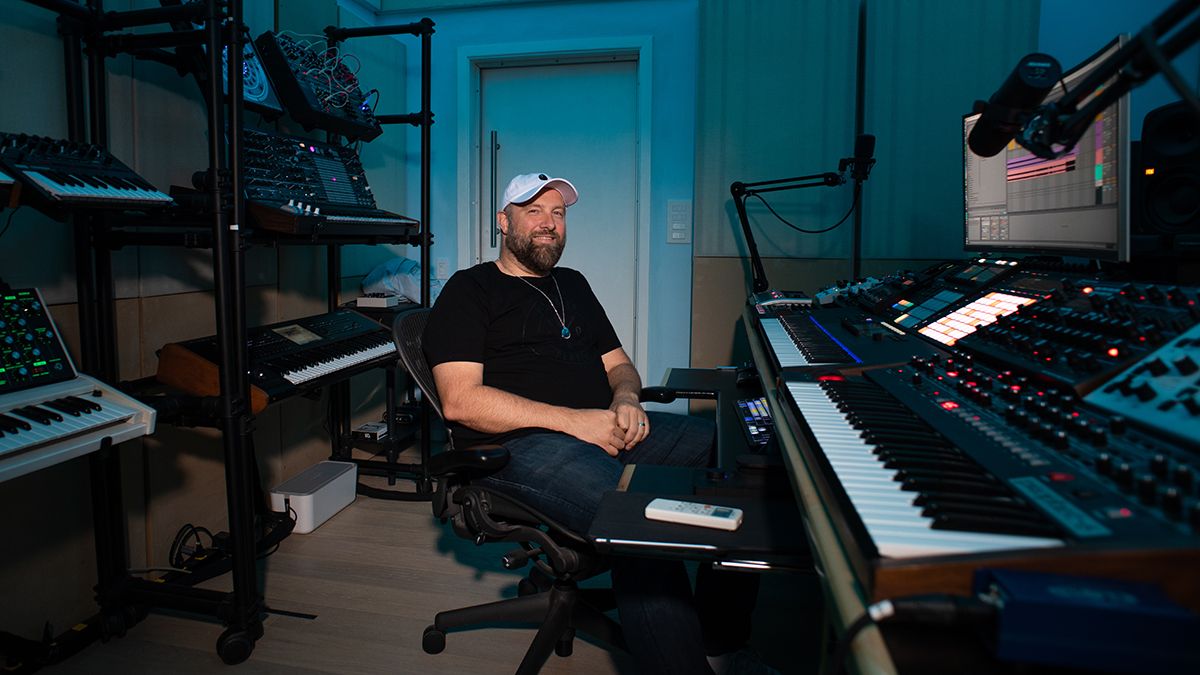
Claude VonStroke, real name Barclay Crenshaw, has an entourage. And they all are grasping for his attention. Before our interview, shirt designs need to be approved and details still need to be finalised for one of the venues for an upcoming DirtyBird barbeque. “It might not be the best time for this,” Crenshaw mentions to his wife Aundy, who helps run both the DirtyBird label and many of the ventures that have poured forth.
DirtyBird started in 2005 and quickly made a name for itself upon the release of the Claude VonStroke single Deep Throat, which sold upwards of 100,000 copies and catapulted the DJ to stages worldwide. Crenshaw now maintains an international touring schedule that, along with his label responsibilities, keeps him from making music as often as he’d like.
But all of that fades to the background when we enter his private studio, a small, custom-built room that is a hardware haven with everything perfectly in reach. Though Crenshaw’s production started in 2003 as a purely in-the-box venture, he now employs a plethora of versatile sound-sculpting instruments, including names from Dave Smith, Arturia, Moog, Native Instruments, and more. It’s here that Crenshaw’s attention to detail and ability to inject his tracks with a playful spirit shines; where he clearly settles into his truest self.
This past April saw the release of Walay (My Bae), a new Claude VonStroke EP that paired larger-than-life drums with the kind of warped vocal chops that he’s now known for. We sat down to chat about which synths have managed to keep his interest over the long run, his analogue-digital hybrid production process, and how the Maschine MK3 has changed his way of working.
You just had a two-track EP come out in April. Can you tell us about what you are currently working on?
“I just finished that EP, and I just finished a remix for Booka Shade. I also have another remix coming out for MØ, and now I’m just starting another Claude VonStroke EP. We’re also going to record my set live at Movement, and we’re going to license everything I play and release it as both a compilation and mix in June. And we’re doing two festivals again, DirtyBird campout, and we have our barbeque series, so we’re super busy!”
How did your collaboration with EPROM come about? We don’t often see you in collab mode…
Get the MusicRadar Newsletter
Want all the hottest music and gear news, reviews, deals, features and more, direct to your inbox? Sign up here.
“I worked with EPROM before under my other alias, Barclay Crenshaw, where we made bass music. I think he’s an amazing producer and it started out as a remix of one of his tracks, but it became such a different thing that we made it a record. That whole air alarm riff came from the (Arturia) MatrixBrute using the sequencer, and then pitching it down in Ableton afterwards.”
Your tracks seem to always include some kind of vocals, whether it’s a short word or phrase or something longer that’s been processed. How does including a vocal change your production process? Do you think about it in advance?
“I always have a vocal. I always really like the kind of things James Brown and Michael Jackson did, where they would throw in little vocal stabs and it would always make the beat funkier, something like ‘huh’ or ‘ah’ – vocal as percussion. I’d say 99% of my songs, in the rhythm of the beat, there’s always a little vocal stab and I think that makes the tracks inherently funkier. Something about hearing a voice inside of a beat that gives it another dimension.”
Are those typically your voice?
“Yeah, it’s always my voice, without a doubt.”
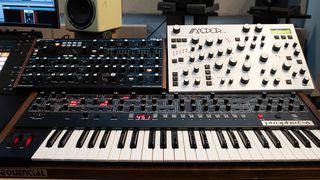
Let’s talk about some of this gear… Your studio seems very ergonomically laid out. What are some of the most used synths in your studio these days?
“I would say the synth I end up using the most is the [DSI] Prophet 6. It kinda has a creepy thing going on with it that I like a lot. In the past I’ve used a lot of Moog Sub 37 and Voyager, but I find myself using the Prophet as a really reliable way to get a weird sound. I used the MatrixBrute on the last EP quite a bit but really everything’s getting used.
“I’m not a pack rat, so if it’s in my studio for eight months and I haven’t touched it, I get rid of it and I get something else. I’ve had the Prophet for a couple of years now, since about six months after it came out. It’s a good Swiss army knife. You could probably just have that and be fine but I like the toys!”
What about monitors – which are your main pair these days?
“For the last three or four months, I’ve been using these Kii Threes, which are a digitally controlled monitor and they fire the sound from seven ports. Theoretically they are supposed to remove a lot of the issues that the room shape would cause. They are really good; they sound awesome, but for the last ten years I’ve used Event Opals, which are also really good.
But to be honest, I still take it out to the car and it’s the only reason I won’t sell this car! I just can’t get rid of it because of the sound system.
“The Opals have a missing bass extension that I’m getting with the Kiis – they’re able to go down to 20Hz or something. I don’t know how they’re doing it in this cabinet because it’s fairly small. I don’t need a sub at all and I’ve actually never used a sub because I couldn’t get the relationship right at all in the room and I think it can be deceiving. You think there is all this bass and then there’s no bass in the club at all.
“But to be honest, I still take it out to the car and it’s the only reason I won’t sell this car! I just can’t get rid of it because of the sound system. It’s an old, used Range Rover Sport, but it has the premium sound system and you can tell exactly how it’s going to sound on the overblown club systems I’m used to. It’s not ‘accurate’, but it works.”
You mentioned that you don’t hold onto gear long that you don’t use. Have you ever sold something and rebought it later?
“I don’t think so, but I’ve almost sold my Voyager five different times, but I just can’t do it. Not sure why. I look at it and just can’t sell it. That’s the synth I’ve had in my arsenal the longest – the longest surviving synth! [laughs]”
Have you ever regretted selling anything once it’s gone?
“No, because I think there’s a lot of amazing technology and it just keeps getting more interesting. I’m not a heavy programmer. I’m more of an experimenter; I hate menus. So, for example, I know everyone loves the Elektron stuff but it’s not for me. Anything that has five menus to get to something, I just can’t do it. You might as well use your computer. But I do like some tracks that people make with them!
“At the beginning even when I started using Maschine, I hated it, but I stuck it out and now I love it. It’s still infuriates me here and there but I think it’s awesome. I wish that I would just learn everything that I have as deeply as possible but my attention span isn’t long enough to just keep things sitting around forever.”
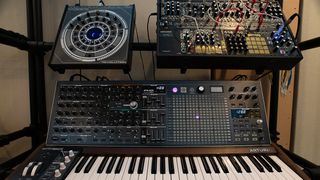
Let’s talk about Maschine a bit. Are you still using it to generate ideas and finishing them off in Ableton?
“Yeah, I think it’s the fastest idea machine for me personally. I have a routine where I wake up, before I do my emails, I try to write a beat or two beats within one hour, whenever it is, and then just put them away. And then every three or four weeks I go into that folder and I’ll listen to everything and see which ones speak to me. I’ll pick four tracks, and then those four tracks will be whittled down to one, and then that’ll be the one I work on.
“When I made this last Barclay Crenshaw album, I did it a different way because I think that volume is actually good for you. I was working on 17 tracks at once instead of one. Because when you work on that many tracks at once, it almost becomes like DJing. Instead of saying, ‘I’m totally stuck on this, let’s abandon it’, it becomes, ‘I’m totally stuck on this, but I can pull in this bassline from that track from a few days ago’, so you can grab parts and move things around and it becomes a lot easier.”
How was the process different for the Barclay Crenshaw record?
“It was a lot different because I went about it in an entirely new way that I had never done before. I went into the studio for a week – Red Bull Studios here in LA – and recorded all live musicians. I played them all songs I liked and tried to make my own sample library of vibes and Rhodes and drum kits, in styles that I can think of but not play myself naturally. Then I would chop all those up so it’s electronic but the pieces are originating in played music. We actually did it again in New York recently for another studio record that I’ll be starting in July.”
Tell us about how you route those pedals. You’re not using a normal patchbay, right?
“I’ve had battles with people over this because I hate patchbays [laughs]. I kept trying to convince someone to help me make a system where I could have a huge pedalboard but every single pedal is on an insert. So now we finally finished this system where I can go through all my pedals but I can just drop them in as external hardware in Ableton.
“I even run Maschine like a hardware drum machine, not a software drum machine; I run the audio out from it. It’s the same thing as the TR-8S next to it. Everything is audio out and then I can go through any of these pedals but I don’t have to wire it up, it’s just set up. Or I can go through the UAD effects, so you can theoretically go through the UAD plugins and then through the Moogerfoogers and whatever chain you want.”
Were you working on tracks while this system was being set up?
“I was, but they were more in the box than I wanted. I’m very fast in the box, but I’ve realised I can’t get that same level of grit in the box. You can get it if you want to go through six passes of flattening audio but even then I don’t think you can really get it. You can get to a place but it’s not going to be the same place.”
What do you reach for out of the box when you are thinking ‘grit’?
“This filter bank that is made by Erica Synths – the Acidbox 3. It sounds very disturbing. It can just do that thing – that nasty, sandpapery thing that is hard to find. But there’s other ways to do it. I use Elektron’s Analog Heat for that as well, which it’s very good at. And the EarthQuaker Bit Commander, though it’s almost too much. If you keep it on the low settings, it can sound great. A lot of these textures are really distorted though, and my sound isn’t mega-distorted, so I try to balance them out.”
What do you run through the Analog Heat?
“A lot of drums, as it seems to sweep up all the garbage on the bottom and warm up the mids. Sometimes it’s just a B-layer, like a parallel version of your drums that you put on another track, just to give it a little bit of talons, to make it a bit tougher.”
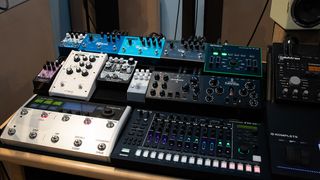
We see you’ve got the new Roland TR-8S. How are you enjoying it so far?
“I’ve had it for five weeks but I was gone for three of those! I’ve been playing with it the last few days though and I think it’s really cool. I like the way you can just flick through the samples and that you can change what’s on each track. And that’s why I run the Maschine analogue using the audio outs, though I wish it had ten outs. It’s already good sounding but you’re just going to sound like everyone else using the same 60 different sample packs in there.”
We’re assuming you started working like that when you got the Maschine MK3?
“Yeah, you couldn’t do it before unless you were using some kind of weird Soundflower configuration. I’m a fan of committing to layers now; it’s just better and faster. But even though you’re running analogue out of Maschine, because it has that drag-and-drop functionality, you can still drag it over [to your DAW] if you have a pattern you want to keep. So it’s like a hardware drum machine now, and I have the MIDI sending to everything else so I can sequence with Maschine. It’s very versatile.”
When you’re sequencing something are you typically focusing on one synth at a time?
“Yeah. I’m not running 16 channels of MIDI through the whole studio, I’m basically running it out, getting a bassline, recording it in, and then going from there. Then I’ll export the MIDI, just to have the backup if I want to use another synth and do it a different way, and then you don’t really even have to save the Maschine project because you have the MIDI saved. But for some reason I’m not trying to get six synths going at the same time. My mind doesn’t really work like that.”
When you’re programming drums are you just focusing on the drums without anything else?
“Yes, but it would be good if I could work on them at the same time as the bassline. But I typically just work on the drums, and then I record them separately as individual channels. But I can see the value of getting the bass and the drums together in that programming stage, and maybe I’ll do that in the future, but I usually work on the drums separately. They do go back and forth, though. I’ll be working on the drums, then working on the bass, and I’ll need to change something in one of the parts, and then I typically bring in the other elements.”
Your tracks always have a sense of playfulness and fun. Does being a dad seep into your creative workflow?
It’s totally ridiculous and it’s the coolest track, you know what I mean? It’s a silly idea but it came out super cool and that’s what I’m trying to get at all the time.
“I think I was always that way, even before I was a dad. I do like to have it be lighthearted but there’s also a line where it’s too goofy. My mentor Green Velvet, if you want to call him that – he was the guy I always looked up to and I’m actually working with him now, which is crazy – he rode the line perfectly. The Percolator is a perfect example. It’s totally ridiculous and it’s the coolest track, you know what I mean? It’s a silly idea but it came out super cool and that’s what I’m trying to get at all the time.”
How do you feel about your mixing skills now that you’ve been doing it longer?
“I’m way better than I used to be and I still suck at it [laughs]. I probably don’t suck but I always think it could be better. Sometimes you spend ten days on what’s really the last 5% of a track so I’ve started actually to send stems to the mastering guy and we’ll go back and forth like that.
“They can get that last 5% way easier than me and I don’t really want to do it! I hate when I go back to a mix and think, ‘if I had just had another two hours I could have cleaned this whole thing up’. Learning about what is fucking up your mix has been extremely helpful. I do a lot of online videos, and just going in and cleaning out all the sub in your clap and other percussion – it’s unbelievable the amount of headroom you can gain by doing that.”
Have you ever considered doing a Claude VonStroke live set?
“Yes, I almost did it this year. I’m trying to decide if anyone cares [laughs]. I don’t know if the audience can tell if I’m playing keyboards and launching 60 different clips or if I’m just pressing play on a CDJ. So, to work on it for eight months and not have the audience really be able to tell… I’d have to do it for me. For my personal love of playing with gear, so I might do it because I do like playing with gear!
“But I don’t think its necessary in this current world, unless the camera is showing your hands and catching every movement. The crowd doesn’t understand the technology usually. I would like to do it; it’s just whether I can fit it in to my schedule. But I still want to make music; I can’t imagine not making music. I’m getting a bit of tinnitus in my right ear, which is super annoying, so I’m really careful now. I pay attention to how many hours I’m in there, and I don’t even step out of the car without my earplugs in when I’m going to a nightclub.”
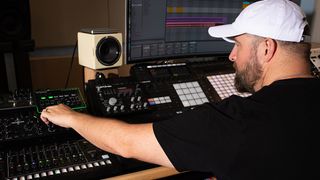
You’ve been making tracks for many years now. What advice would you give to the beginning producer version of yourself?
“I actually think I started out in the right way, which is don’t care about what other producers are doing, at all. Be on an island. Sonically, everyone claims that they do this but no one really does it, but go get your three favourite songs and use them as reference when you’re mixing. I still forget to do that. Creatively, though, throw out the rulebook, because I’m getting 250 demos a week just for DirtyBird and there are a lot of very similar tracks. Anything that sticks out or sounds really interesting or original really sticks out, dramatically.
I actually think I started out in the right way, which is don’t care about what other producers are doing, at all.
“For beginning producers, I think it’s really important to generate some kind of system where you can just get things done and not hold onto things for six months. If it sucks, it sucks but at least you can go on to the next thing and you can really get a consistent schedule of writing because there’s a huge difference between writing the idea and working in Ableton doing EQing and moving things around for ten hours. That’s the work part. The writing part is the creative part, and that could be ten minutes or it could be 40 minutes or two hours but those two things aren’t the same and I think a lot of people do the second half and think they’re writing the music, but they’re really just making the kick sound big. Always try to keep going on a creative spurt.”
Have you ever signed anything to DirtyBird from a demo?
“Oh yeah, a lot. I listen to the demos still, every single one, and I’ve found countless people in these things. It’s amazing. Even two or three years ago, that Shiba San track was just in the demo pile.
“We’ve had number ones come out of the demo pile. You have to have patience if you’re just sending it in to the generic demo pile though, because if you think about it from my side, I’ve gotta go through them once every two weeks. Then I’ve gotta hone down that pile that I like. Then I take those tracks out on the road with me and I see which ones I really like on the dancefloor and that takes another two weeks or so, so it could be two months before you even get a response. It’s kind of a long wait, but the ones that I pick, I really believe in and will push them to death.”
And how exactly did you train yourself to finish tracks when you were getting going?
“I had to really change my personality, which seems impossible. My personality is really a perfectionist type – leave no detail dirty. Even on the t-shirts we make, I want every detail to be perfect. But if it’s gotta be perfect you’re gonna release one record per year, maybe, and it’s not gonna be good! It’s not going to have that raw feeling and it’ll be over analysed and over-produced. Just gotta let go – it’s just dance music!”



“My love letter to a vanished era that shaped not just my career but my identity”: Mark Ronson’s new memoir lifts the lid on his DJing career in '90s New York
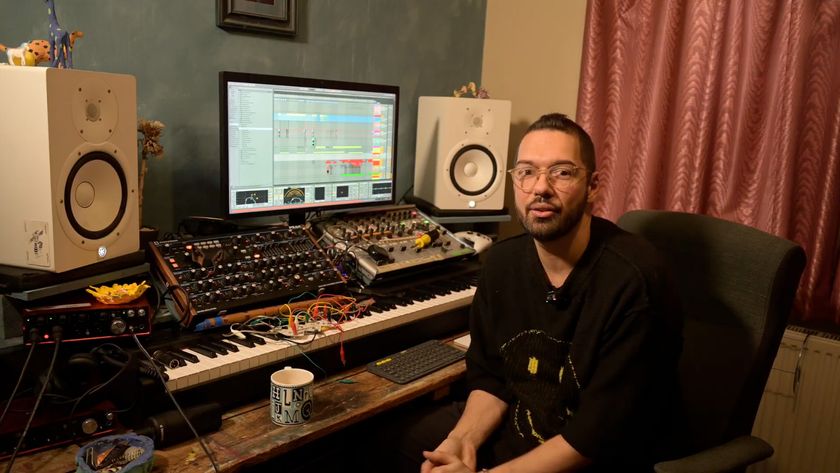
“I'm always starting up sessions and not finishing them, but I don't see that as unproductive”: Virtuosic UK producer Djrum talks creativity and making Frekm Pt.2








